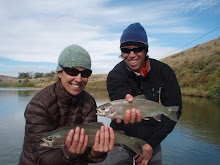By Rick Kustich
photos by David Klausmeyer
The ability to see your fly on the water will help you achieve better drifts and hook more trout.
Thorax Dun
Hook: Daichi 1170. sizes 12 through 16.
Thread: To match the color of the natural insect, 8/0.
Wing post: Light dun Aero Dry cut to form general shape of a mayfly wing.
Tail: Microfibbetts.
Body: Superfine dubbing to match the color of the natural insect.
Hackle: Dry-fly hackle to match the color of the body. Trim the hackle flat on the bottom so that the pattern rides low.
DRY-FLY DESIGN has been the subject of many discussions with one of my longtime fly-fishing partners, Nick Pionessa, who is a full-time fly tier. His flies end up in some of the better-known shops in the country. We agree that perhaps one of the more important aspects of a dry fly is how visible it is on the water. Not only does this let you see when a fish takes the fly, but it allows you to see how the fly is drifting, as well.
A drag-free drift is often essential to fool a discriminating trout. Unless you can see the fly clearly, it is difficult or even impossible to tell whether you are making a good dead drift. A poor drift results in more refusals than does poor fly selection, so you need to be able to follow the path of the fly to read the impact of the subtle currents that often cannot be seen just by looking at the water's surface. This is especially true when you are making long casts. Being able to see the fly lets you make adjustments to your presentation or position to obtain the proper drift. With a high-visibility fly — one you can see from a long way off — you can easily track your drift and see whether the trout that just rose ate your fly or a natural drifting alongside it.
The challenge is to produce flies you can see from a distance, but without compromising their realistic appearance. Happily, the fly needs to look like a natural insect only from the fish's point of view. This usually allows for some flexibility on the top of the fly. Highly visible wings, posts, or small pieces of foam tied in on the top will dramatically improve how easy it is to see the fly. At the same time, the fly's key elements — such as the body, tails, legs, or shuck — can still offer an impressionistic look from underneath.
Read more here!
 A rare warm December day in Casper yielded some fine results on the Reef. Plenty of big rainbows were happy to take small midges and an egg here and there. The Engagement Hole never fails to deliver a smile! There were moments that I realized how lucky I was to be immersed in this spectacular place partaking in a pursuit that I love.
A rare warm December day in Casper yielded some fine results on the Reef. Plenty of big rainbows were happy to take small midges and an egg here and there. The Engagement Hole never fails to deliver a smile! There were moments that I realized how lucky I was to be immersed in this spectacular place partaking in a pursuit that I love. 



